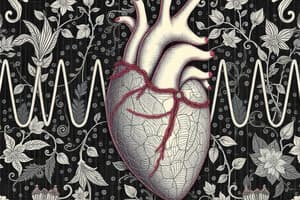Podcast
Questions and Answers
What is the most common cause of atrioventricular (AV) block?
What is the most common cause of atrioventricular (AV) block?
- Genetic disorders
- Increased vagal tone
- Idiopathic fibrosis and sclerosis of the conduction system (correct)
- Ischemic heart disease
Which of the following statements best describes First Degree AV Block?
Which of the following statements best describes First Degree AV Block?
- All P waves are followed by QRS complexes with a PR interval greater than 0.20 seconds. (correct)
- Some P waves are not followed by QRS complexes.
- There is complete dissociation between P waves and QRS complexes.
- PR interval is consistently normal.
Which characteristic differentiates Mobitz type I from Mobitz type II Second Degree AV Block?
Which characteristic differentiates Mobitz type I from Mobitz type II Second Degree AV Block?
- Molitz type II has progressively lengthening PR intervals.
- Mobitz type I has a progressively lengthening PR interval until a QRS complex is dropped. (correct)
- Mobitz type I features dropped QRS complexes at regular intervals.
- PR interval is constant in Mobitz type I.
What does third-degree AV block signify?
What does third-degree AV block signify?
In Mobitz type II Second Degree AV Block, how does the PR interval behave?
In Mobitz type II Second Degree AV Block, how does the PR interval behave?
What is a characteristic finding in Mobitz type I AV Block regarding QRS complexes?
What is a characteristic finding in Mobitz type I AV Block regarding QRS complexes?
What is the typical heart rate observed in First Degree AV Block?
What is the typical heart rate observed in First Degree AV Block?
Which of the following medications is NOT commonly associated with AV block?
Which of the following medications is NOT commonly associated with AV block?
Flashcards are hidden until you start studying
Study Notes
Atrioventricular (AV) Block
- AV block is an interruption of electrical impulses traveling from atria to ventricles
Causes of AV Block
- Idiopathic fibrosis & sclerosis of conduction system (50% of patients)
- Ischemic heart disease (40%)
- Medications (beta-blockers, calcium channel blockers, digoxin, amiodarone)
- Increased vagal tone
- Valvulopathy
- Congenital heart disease, genetic, or other disorders
First Degree AV Block
- All normal "P" waves are followed by "QRS" complexes
- PR interval is longer than normal, greater than 0.20 seconds
- Rate: 60 bpm
- Rhythm: Regular
- P wave: Normal
- PR interval: 0.32 sec
- QRS: 0.08 sec
Second Degree AV Block
- Some "P" waves are followed by "QRS" complexes, while others are not
- Divided into Mobitz Type I and Mobitz Type II
Mobitz Type I
- PR interval progressively lengthens with each beat until atrial impulse is not conducted and "QRS" complex is dropped
- Also called Wenckebach phenomenon
- AV nodal conduction resumes with the next beat, and the sequence repeats
- Rate: 60 bpm
- Rhythm: Regularly irregular
- P wave: Present, 1-2 before "QRS"
- PR interval: 0.2-0.36 sec (progressively lengthens)
- QRS: 0.08 sec, skipped every after 3 beats
Mobitz Type II
- PR interval is constant
- Beats are intermittently nonconducted and "QRS" complexes dropped, usually in a repeating cycle of every 3rd (3:1 block) or 4th (4:1 block) "P" wave
- Rate: 60 bpm
- Rhythm: Regularly irregular
- P wave: Normal, present
- PR interval: 0.12 sec
- QRS: 0.08 sec, skipped every after 3 beats
Third-Degree AV Block
- Complete heart block with no electrical communication between atria and ventricles
- No relationship between "P" waves and "QRS" complexes (AV dissociation)
Studying That Suits You
Use AI to generate personalized quizzes and flashcards to suit your learning preferences.




